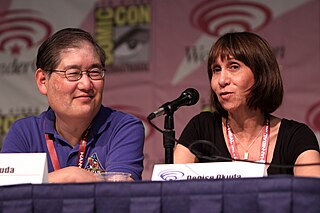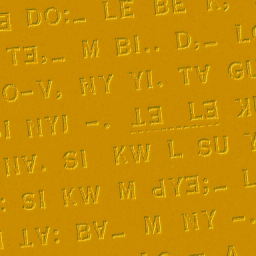| Klinzhai or Mandel script | |
|---|---|
| Type | Alphabet – Latin cipher |
| Languages | Klingonaase? |
| pIqaD | |
|---|---|
| Type | |
| Languages | tlhIngan Hol (Klingon) |
| Direction | Left-to-right |
| ISO 15924 | Piqd, 293 |
| CSUR U+F8D0..U+F8FF | |
Klingon alphabets are fictional alphabets used in the Star Trek movies and television shows to write the Klingon language.
Star Trek is an American space opera media franchise based on the science fiction television series created by Gene Roddenberry. The first television series, simply called Star Trek and now referred to as "The Original Series", debuted in 1966 and aired for three seasons on NBC. It followed the interstellar adventures of Captain James T. Kirk and his crew aboard the starship USS Enterprise, a space exploration vessel built by the United Federation of Planets in the 23rd century. The Star Trek canon includes The Original Series, an animated series, five spin-off television series, the film franchise, and further adaptations in several media.
The Klingon language, sometimes called Klingonese, is the constructed language spoken by the fictional Klingons in the Star Trek universe.
Contents
- KLI pIqaD
- ConScript Unicode Registry
- Earlier variations
- Skybox pIqaD
- Mandel script
- Wikipedia logo
- See also
- References
- External links
In Marc Okrand's The Klingon Dictionary this alphabet is named as pIqaD, but no information is given about it. When Klingon symbols are used in Star Trek productions they are merely decorative graphic elements, designed to simulate real writing and to create an appropriate atmosphere.

Marc Okrand is an American linguist. His professional work is in Native American languages, and he is well known as the creator of the Klingon language in the Star Trek science fiction franchise.

The Klingon Dictionary (TKD) is a book by Marc Okrand describing the Klingon language. First published in 1985 and then again with an addendum in 1992, it includes pronunciation, grammar and vocabulary. It has sold more than three hundred thousand copies and has been translated into five languages.

Writing is a medium of human communication that represents language and emotion with signs and symbols. In most languages, writing is a complement to speech or spoken language. Writing is not a language, but a tool used to make languages be read. Within a language system, writing relies on many of the same structures as speech, such as vocabulary, grammar, and semantics, with the added dependency of a system of signs or symbols. The result of writing is called text, and the recipient of text is called a reader. Motivations for writing include publication, storytelling, correspondence, record keeping and diary. Writing has been instrumental in keeping history, maintaining culture, dissemination of knowledge through the media and the formation of legal systems.
The Astra Image Corporation designed the symbols (currently used to "write" Klingon) for Star Trek: The Motion Picture , although these symbols are often incorrectly attributed to Michael Okuda. [1] They based the letters on the Klingon battlecruiser hull markings (three letters) first created by Matt Jeffries, and on Tibetan writing because the script had sharp letter forms—used as an allusion to the Klingons' love for bladed weapons.

Star Trek: The Motion Picture is a 1979 American science fiction film directed by Robert Wise and based on the television series of the same name created by Gene Roddenberry, who also served as its producer. It is the first installment in the Star Trek film series, and stars the cast of the original television series. The film is set in the year 2271, when a mysterious and immensely powerful alien cloud known as V'Ger approaches Earth, destroying everything in its path. Admiral James T. Kirk assumes command of the recently refitted Starship USS Enterprise, to lead it on a mission to save the planet and determine V'Ger's origins.

Michael Okuda is an American graphic designer best known for his work on Star Trek.
In the Star Trek franchise, the Klingon Empire makes use of several classes of starships. As the Klingons are portrayed as a warrior culture, driven by the pursuit of honor and glory, the Empire is shown to use warships almost exclusively and even their support ships, such as troop transports and colony ships, are armed for battle. This contrasts with the exploration and research vessels used by Starfleet, the protagonists of the franchise. The first Klingon ship design used in The Original Series, the D7-class battlecruiser, was designed by Matt Jefferies to evoke a shape akin to that of a manta ray, providing a threatening and instantly recognizable form for viewers. The configuration of Jefferies's design featured a bulbous forward hull connected by a long boom to a wing-like main hull with the engine nacelles mounted on each wingtip. Though a variety of Klingon ships have appeared in Star Trek, their design generally conforms to this style. Most Klingon vessels were physically built as scale models, although later computer-generated imagery was used to create the models. In recent years, many of the original studio models have been sold at auctions.












